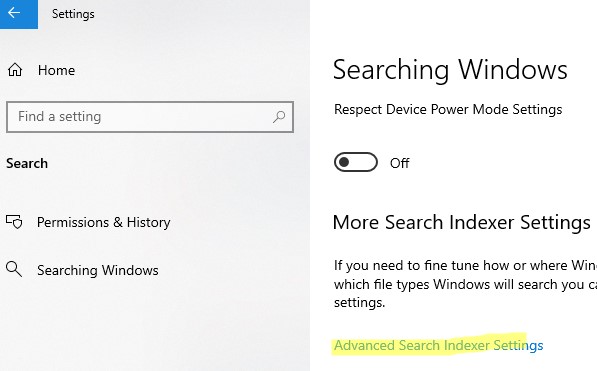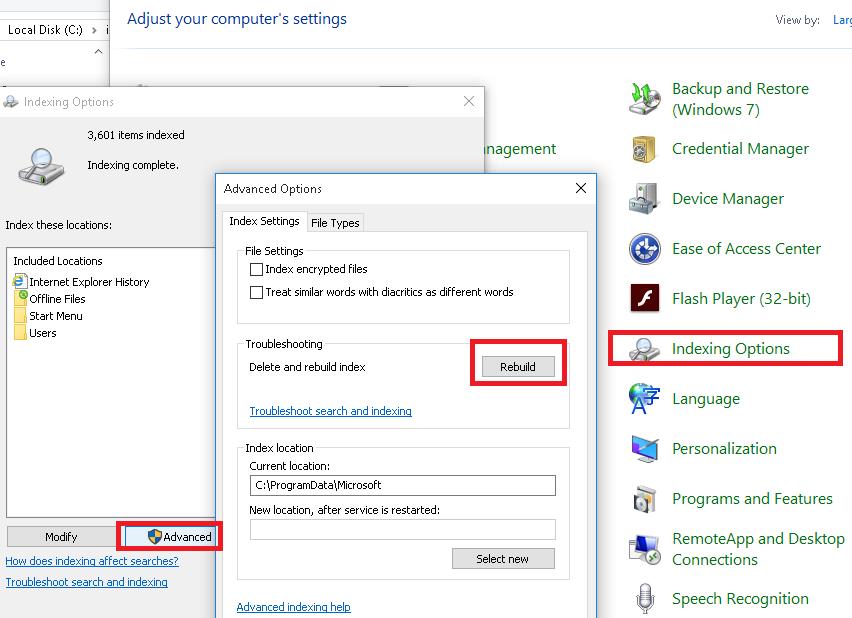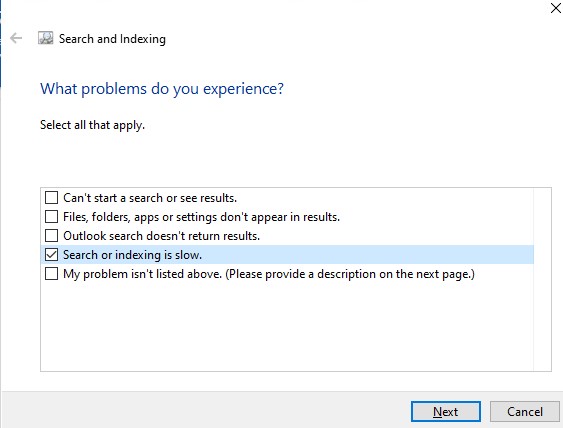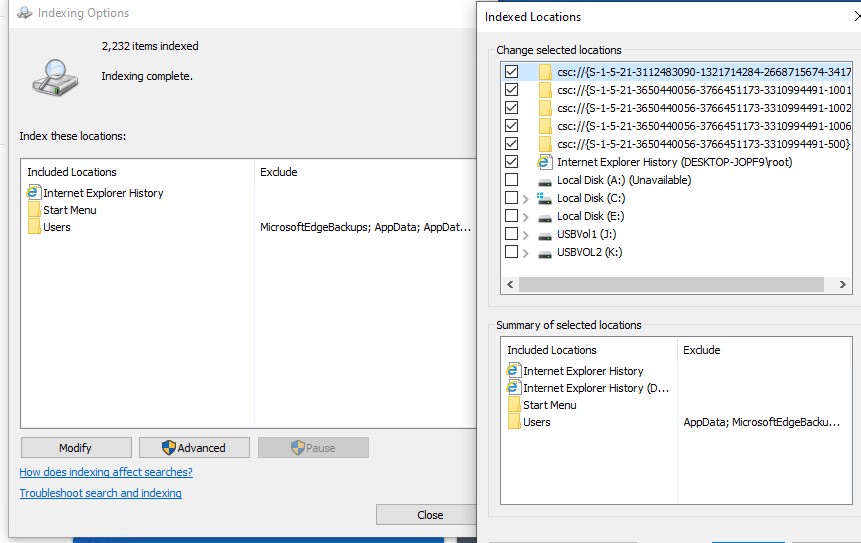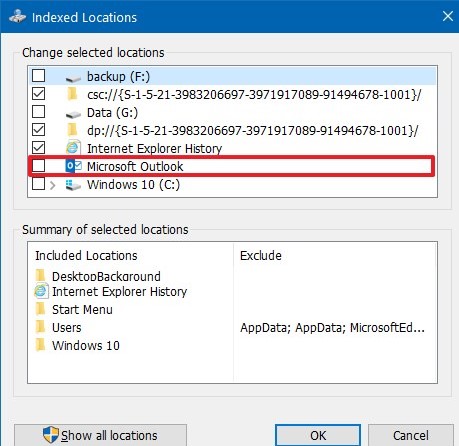Файл Windows.edb (Windows.db в Windows 11) хранит индексную базу данных службы поиска Windows (Windows Search). Поисковый индекс позволяет пользователям выполнять быстрый поиск файлов, электронных писем в pst файлах и другого контента на диске. Индексирование файлов выполняется в фоновом режиме процессом
SearchIndexer.exe
. При большом количестве файлов на диске размер файла Windows.edb может вырастать до десятков и даже сотен Гб, занимая все свободное место на системном диске.
Содержание:
- Сбросить поисковый индекса службы Windows Search
- Уменьшаем размер файла Windows.edb с помощью дефрагментации
- Ручное удаление и пересоздание файла Windows.edb
- Перенос файла Windows.edb на другой диск
- Почему сильно растет размер файла Windows.edb
Файл Windows.edb является скрытым и по-умолчанию хранится в каталоге C:\ProgramData\Microsoft\Search\Data\Applications\Windows\.
В Windows 11 вместо файла Windows.edb для хранения индекса службы поиска используется файл Windows.db.
Чтобы быстро узнать текущий размер файла Windows.edb можно воспользоваться PoweShell командой:
((Get-Item $env:programdata'\Microsoft\Search\Data\Applications\Windows\Windows.edb').length/1GB)

В моем примере при поиске больших файлов на диске, я обнаружил что размер файла Windows.edb вырос до 15,5 Гб (а это почти 15% на моем 100 Гб SSD диске).
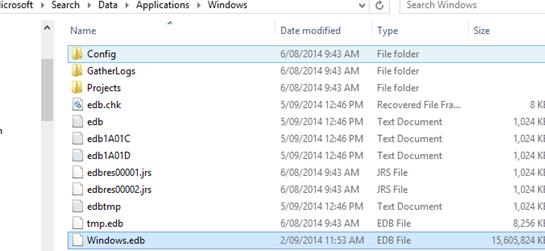
Далее рассмотрим, как уменьшить размер индексного файла Windows.edb службы поиска Windows.
Сбросить поисковый индекса службы Windows Search
Для уменьшения размера файла Windows.edb можно использовать встроенную функцию Windows Search, которая выполняет полную переиндексации содержимого диска.
- Откройте панель Settings -> Search -> Searching Windows -> Advanced Search Indexer Settings (в классической Control Panel перейдите в Indexing Options, или выполните команду
сontrol srchadmin.dll
); - Нажмите кнопку Advanced -> Rebuild;
- Windows Search удалит старый файл Windows.edb, выполнит сканирование диск, переоздаст и перестроит индексный файл. Этот процесс может занять длительное время в зависимости от количества файлов на диске.
Уменьшаем размер файла Windows.edb с помощью дефрагментации
Индексный файл службы поиска Windows представляет собой базу в формате EDB. Можно выполнить офлайн дефрагментацию EDB базы с помощью встроенной утилиты esentutl.exe (Extensible Storage Engine Utility), хорошо знакомой администраторам Exchange. Воспользуйтесь готовым BAT скриптом для остановки службы Windows Search и офлайн дефрагментации файла Windows.edb:
sc config wsearch start=disabled
sc stop wsearch
esentutl.exe /d %ProgramData%\Microsoft\Search\Data\Applications\Windows\Windows.edb
sc config wsearch start=delayed-auto
sc start wsearch
Совет. Для выполнения дефрагментации EDB базы на диске должно быть достаточно свободного места, т.к. будет создана копия edb файла.
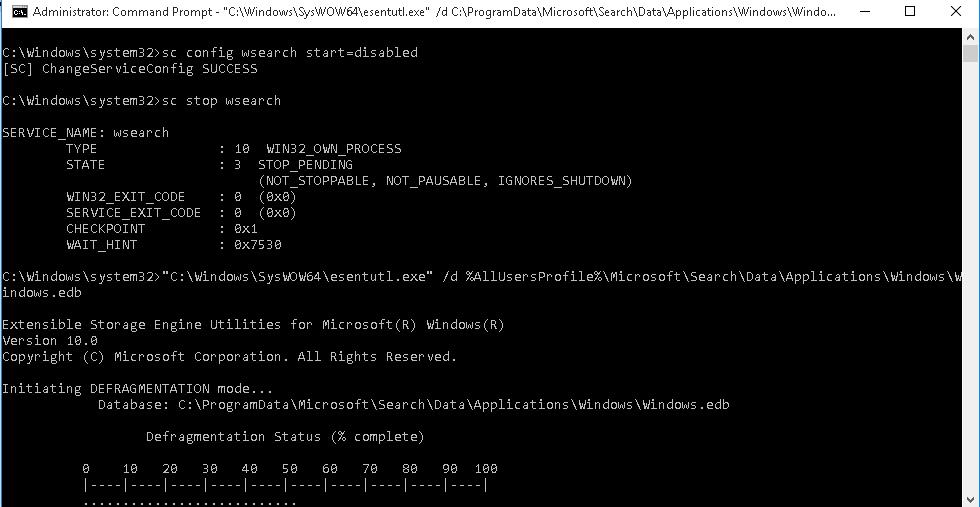
Дефрагментации позволяет уменьшить размер базы поиска на 20-50 процентов
Этот способ можно применить для дефрагментации файла службы поиска на всех версиях Windows, кроме Windows 11. В Windows 11 вместо файла Windows.edb с типом базы данных JET, используется новый формат файла Windows.db. Это база данных на базе SQLite, которую нельзя индексировать с помощью esentutl.exe.
Ручное удаление и пересоздание файла Windows.edb
Если места на диске критически мало, можно вручную удалить файл Windows.edb. Это действие безопасно, т.к. вы не теряете никакие данные, сбрасывается только поисковый индекс. Для удаления файла Windows.edb остановите службу Windows Search, затем удалите файл и запустите службу.
net stop "Windows Search"
REG ADD "HKLM\SOFTWARE\Microsoft\Windows Search" /v SetupCompletedSuccessfully /t REG_DWORD /d 0 /f
del %PROGRAMDATA%\Microsoft\Search\Data\Applications\Windows\Windows.edb
net start "Windows Search"
Параметр реестра
SetupCompletedSuccessfully = 0
указывает службе Windows Search, что нужно восстановить настройки по-умолчанию.
После перезапуска, служба Windows Search начнет процесс переиндексации данных на дисках компьютера и пересоздаст файл Windows.edb (в процессе полной переиндексации производительность системы может снизится).
Перенос файла Windows.edb на другой диск
В некоторых сценариях пользователи могут активно использовать поиск на диске через Windows Search (например, пользователи терминального RDS сервера часто используют поиск в папках и личных PST файлах). В таком случае, если вы не можете кардинально уменьшить размер файла Windows.edb или постоянно сбрасывать поисковые индексы, вы можете перенести его с системного раздела на другой диск.
Для смены местоположения файла перейдите в Control Panel –> Indexing Options -> Advanced -> Index location-> New Location и укажите путь к новому местоположению файла Windows.edb и нажмите OK.
Перезапустите службу поиска:
Restart-Service wsearch
Почему сильно растет размер файла Windows.edb
Если после дефрагментации и/или перестройки поискового индекса, его размер опять начинает сильно расти, попробуйте следующие методики, которые могут помочь решить проблему.
- Запустите встроенное средство исправления неполадок поиска Windows (Search and Indexing Troubleshooter). Выполните команду:
msdt.exe -ep SystemSettings_Troubleshoot_L2 -id SearchDiagnostic
. В списке проблем выберите, что поиск или индексация выполняется медленно (Search or indexing is slow). Далее мастер устранения неполадок попробуем вернуть службу Windows Search в нормальное состояние; - Старайтесь индексировать только необходимые контент. Исключайте из поискового индекса элементы, поиск в которых вы не используете. Нажмите кнопку Modify в настройках индексирования и в окне Indexing Location отключите пути и приложения, которые не нужно индексировать. После изменения настроек путей индексирования перестройте индекс Advanced -> Rebuild;
- Если вы используете на компьютере Outlook с PST файлами, то при их индексировании размер файла Windows.edb растет пропорционально размеру PST файлов. Это может привести к исчерпанию места на диске и проблемам с производительностью. В этом случае Microsoft рекомендует исключить Outlook из списка индексируемых элементов.
Естественно при этом в Outlook перестанет работать поиск (это не будет проблема, если вы храните своя ящик на сервере Exchange с включенным поисковым индексом);
- Если ничего не помогает, и размер файла постоянно растет, вы можете полностью отключить службу wsearch, или настроить логон скрипт, который сбрасывает поисковый индекс при каждой загрузке компьютера.
Среди файлов Windows 11 вы можете обнаружить файл Windows.db, а в файлах Windows 10 — Windows.edb, который в некоторых случаях может занимать значительное место на диске компьютера.
В этом материале подробно о том, для чего нужен файл Windows.edb или Windows.db, как уменьшить его размер, если он стал слишком большим и можно ли его удалить.
Назначение файла Windows.edb или Windows.db

Файл Windows.edb в Windows 10 или Windows.db в Windows 11, находящийся в папке
C:\ProgramData\Microsoft\Search\Data\Applications\Windows
содержит данные индексирования, необходимые для работы поиска в Windows.
Обычно, при параметрах индексирования по умолчанию, Windows.edb или Windows.db не занимает много места, но в некоторых случаях может начать «неограниченно» расти. Для этой ситуации возможны следующие решения:
- Перестроить индекс и устранить причину разрастания файла
- Выполнить дефрагментацию файла индекса
- Отключить индексирование Windows и удалить этот файл, если вы не пользуетесь системным поиском
По порядку рассмотрим каждый из вариантов.
Удаление и перестроение поискового индекса, изменение параметров индексирования
Первый и предпочтительный вариант — удалить и перестроить поисковый индекс, а также изменить настройки индексируемых расположений, поскольку часто именно этот фактор влияет на бесконтрольный рост файла Windows.edb/Windows.db. Шаги будут следующими:
- Откройте панель управления (для этого можно использовать поиск в панели задач), а в ней — пункт «Параметры индексирования». Также в нужное окно можно попасть с помощью Win+R и команды
control.exe srchadmin.dll
- Если в списке индексируемых расположений есть «Microsoft Outlook», нажмите кнопку «Изменить» и отключите индексирование этого элемента (снимите с него отметку и примените изменения) — обычно именно он оказывается причиной роста файла.
- Нажмите кнопку «Дополнительно» в параметрах индексирования, а затем — кнопку «Перестроить» в пункте «Удалить и перестроить индекс».
В результате файл Windows.edb или Windows.db будет удален, создан заново и начнет автоматически заполняться данными индексирования уже с вновь заданными параметрами.
Дефрагментация базы данных поискового индекса
Этот способ, который потенциально способен уменьшить размер файла поискового индекса, подойдет только для Windows 10, и предлагается Майкрософт как вариант решения при увеличении размера файла:
- Запустите командную строку от имени администратора.
- По порядку введите следующие команды
sc config wsearch start=disabled net stop wsearch esentUtl.exe /d %AllUsersProfile%\Microsoft\Search\Data\Applications\Windows\Windows.edb sc config wsearch start=delayed-auto net start wsearch
В ходе выполнения команд будет временно отключена служба Windows Search, выполнена автономная дефрагментация файла поискового индекса, а затем служба будет вновь включена и запущена.
Как удалить файл Windows.edb или Windows.db
Вы можете удалить рассматриваемый файл, но без отключения индексирования и службы Windows Search (что отключить и поиск в Windows) он будет автоматически создан заново. Для удаления достаточно выполнить следующие шаги:
- Нажмите клавиши Win+R на клавиатуре, введите services.msc и нажмите Enter.
- В списке служб найдите Windows Search и дважды нажмите по ней.
- Нажмите кнопку «Остановить», а после остановки службы — установите тип запуска в «Отключена» и примените настройки.
- Удалите файл Windows.edb или Windows.db из папки
C:\ProgramData\Microsoft\Search\Data\Applications\Windows
Учитывайте: если после удаления файла вы вновь установите параметры запуска службы Windows Search по умолчанию (Автоматически с отложенным запуском), при первом запуске служба может сообщить об ошибке: но в дальнейшем, после создания файла, заработает в обычном режиме.
Для быстрого поиска по файлам с отключенной службой Windows Search можно использовать эффективный сторонний поиск Everything.
Applies ToWindows 8 Windows 8 Pro Windows 8 Enterprise Windows Server 2012 Datacenter Windows Server 2012 Datacenter Windows Server 2012 Essentials Windows Server 2012 Foundation Windows Server 2012 Foundation Windows Server 2012 Standard Windows Server 2012 Standard
Симптомы
В Windows 8 и Windows Server 2012 служба поиска Windows может раздувать размер файла Windows.edb. В этом случае файл Windows.edb будет увеличиваться вплоть до очень большого размера и займёт много места на диске. В некоторых случаях размер файла может быть больше 50 гигабайт (ГБ).
Решение
Сведения об обновлении
Для решения этой проблемы установите набор обновлений 2836988 для Windows 8 и Windows Server 2012. Дополнительные сведения о том, как получить этот накопительный пакет обновления, щелкните следующий номер статьи базы знаний Майкрософт:
2836988 Windows Server 2012 и Windows 8 накопительный пакет обновления: Май 2013Примечание. Это обновление является профилактическим, но не исправлением. Чтобы уменьшить размер файла Windows.edb, который уже подвержен этой проблеме, после установки данного обновления необходимо перестроить индекс поиска.
-
Проведите пальцем от правого края экрана, а затем коснитесь кнопки Поиск. Или, если вы используете мышь, переведите указатель в правый нижний угол экрана и нажмите кнопку Поиск.
-
Коснитесь или щелкните Параметры.
-
В поле поиска введите Параметры индексирования.
-
Коснитесь или щелкните Параметры индексирования.
-
Коснитесь или нажмите кнопку Дополнительно.
-
Коснитесь или нажмите кнопку Перестроить на вкладке « Параметры индексирования ».
-
Коснитесь или щелкните OK для подтверждения.
-
Измените службу поиска Windows, чтобы он не запускается автоматически. Чтобы сделать это, выполните следующую команду в cmd.exe:
Sc config wsearch start=disabled
-
Выполните следующую команду, чтобы остановить службу поиска Windows:
Net stop wsearch
-
Выполните следующую команду для выполнения автономного сжатия файла Windows.edb:
esentutl.exe /d %AllUsersProfile%\Microsoft\Search\Data\Applications\Windows\Windows.edb
-
Выполните следующую команду, чтобы изменить службу поиска Windows для отложенного запуска:
Sc config wsearch start=delayed-auto
-
Выполните следующую команду, чтобы запустить службу:
Net start wsearch
Статус
Корпорация Майкрософт подтверждает, что это проблема продуктов Майкрософт, перечисленных в разделе «Относится к».
Дополнительные сведения
Для получения дополнительных сведений о терминологии обновлений программного обеспечения щелкните следующий номер статьи базы знаний Майкрософт:
Описание 824684 Стандартные термины, используемые при описании обновлений программных продуктов Майкрософт
Нужна дополнительная помощь?
Нужны дополнительные параметры?
Изучите преимущества подписки, просмотрите учебные курсы, узнайте, как защитить свое устройство и т. д.
On Windows 10, the “Windows.edb” is the database that stores the indexing content for the Windows Search feature to provide faster results for files, emails, and other contents.
Although it’s an essential system file (located in %ProgramData%\Microsoft\Search\Data\Applications\Windows), over time, it can grow very large as you store more files on your device. Also, if you use an email client like Outlook and Search is configured to index a PST file, the size of the Windows.edb database can eventually become a huge file (hundreds of gigabytes), making the system unusable and preventing you from storing any more files.
If you notice that the ProgramData is too big, or you have already identified that the Windows.edb is the reason your computer is running out of space, there are at least two workarounds to reduce the size of the Windows Search database.
This guide will teach you the steps to delete (and reduce the size of) the Windows.edb database file when it has grown very large, you’re running out of space, and you can no longer operate your Windows 10 computer.
- Delete Windows.edb file on Windows 10
- Reduce Windows.edb file size on Windows 10
Delete Windows.edb file on Windows 10
To delete and recreate the Windows.edb file, use these steps:
-
Open Settings on Windows 10.
-
Click on Search.
-
Click on Searching Windows.
-
Click the “Advances Search Indexer Settings” option.
-
Click the Advanced button.
-
Under the “Troubleshooting” section, click the Rebuild button to delete the Windows.edb file.
-
Click the OK button.
-
Click the Modify button from the “Indexing Options.”
-
Clear the Microsoft Outlook option.
-
Click the OK button.
-
Click the Close button.
Once you complete the steps, the Windows.edb file will be deleted and replaced with a new smaller version to index the Windows Search database file returning the “ProgramData” folder and Windows.edb file to their normal size.
Reduce Windows.edb file size on Windows 10
Alternatively, if you don’t want to rebuild the index database on Windows 10, you can defrag the Windows.edb to reduce its size.
To defragment the Windows.edb database to reduce its size on Windows 10, use these steps:
-
Open Start.
-
Search for Command Prompt, right-click the top result, and select the Run as administrator option.
-
Type the following command to prevent Windows Search from starting automatically and press Enter:
sc config wsearch start=disabled
-
Type the following command to stop the search service and press Enter:
net stop wsearch
-
Type the following command to defrag the Windows.edb file to make it smaller and press Enter:
esentUtl.exe /d %AllUsersProfile%\Microsoft\Search\Data\Applications\Windows\Windows.edb
-
Type the following command to delay the Windows Search during startup and press Enter:
sc config wsearch start=delayed-auto
-
Type the following command to start the search service on Windows 10 and press Enter:
net start wsearch
After you complete the steps, the process should reduce the size of the Windows.edb file reclaiming a lot of space on the hard drive making your device operational one more time.
If you don’t have a lot of files but you use the Outlook app, it’s also recommended to reduce the number of emails that client downloads to prevent the database from growing too big quickly.
Why You Can Trust Pureinfotech
The author combines expert insights with user-centric guidance, rigorously researching and testing to ensure you receive trustworthy, easy-to-follow tech guides. Review the publishing process.
You can reduce the Windows.edb size differently, including defragmenting, removing, re-creating, and moving the windows.edb file into another drive, and so on.
Here at Bobcares, we have seen several such Windows-related queries as part of our Server Management Services for web hosts and online service providers.
Today, we’ll take a look at how to reduce windows.edb size.
How to reduce Windows.edb huge File Size
The Windows.edb is a database file of the Windows Search index. It mainly provides content indexing, property caching, and search results for files, e-mail, and other content.
The indexing process is done in the background using the SearchIndexer.exe process. So ,the size of the Windows.edb file increases when there are more files in the system.
By default, the Windows.edb file is located in the below path.
C:\ProgramData\Microsoft\Search\Data\Applications\Windows\Windows.edb
Here is the PowerShell command to check the current size of the Windows.edb file.
((Get-Item $env:programdata’\Microsoft\Search\Data\Applications\Windows\Windows.edb’).length/1GB)Now let’s take a look at how our Support Engineers reduce the file size of Windows.edb file.
1. How to Reset and Rebuild the Windows Search Index
This is one of the most appropriate, though not too effective, ways to reduce the size of Windows.edb. This involves re-indexing the files in the system.
To do it, first, open Control Panel >> Indexing Options >> Advanced >> click Rebuild (to open this dialog box, run the following command:
Control srchadmin.dll).
Within a few minutes, the Windows Search will complete a full reindex of the data on the system drive. This will reduce the size of the edb file.
2. Reduce Windows.edb size using Defragmentation
The EDB database can be defragmented using the standard tool for maintaining such databases, esentutl.exe. You need to defragment the database offline. so first, stop the Windows Search service. Then run the below bat/cmd script.
sc config wsearch start=disabled sc stop wsearch esentutl.exe /d %ProgramData%\Microsoft\Search\Data\Applications\Windows\Windows.edb sc config wsearch start=delayed-auto sc start wsearchMake a note that you have enough space in the hard drive, as a copy of the EDB file is created in it.
3. Remove and Recreate the Windows.edb file
You can safely delete the Windows.edb file if the free disk space is critical. It is safe because you don’t lose any data, instead only the search index is reset.
In order to delete the Windows.edb file, stop the Windows Search service, then delete the file and start the service.
net stop "Windows Search" REG ADD "HKLM\SOFTWARE\Microsoft\Windows Search" /v SetupCompletedSuccessfully /t REG_DWORD /d 0 /f del %PROGRAMDATA%\Microsoft\Search\Data\Applications\Windows\Windows.edb net start "Windows Search"Once you restart the Windows Search, it will start the background reindexing process and recreate the Windows.edb file.
4. Moving the Windows.edb file into a Different Drive
If the Windows.edb file size is growing constantly, then it is better to move the index database of Windows Search to another drive. So, if there is an increase in the search database, it won’t cause the OS to crash.
So to change the index file location, go to Control Panel >> Indexing Options >> Advanced >> Index location >> New Location, and specify the path to the new location of Windows.edb file, and click Ok.
Now restart the Windows Search service.
Restart-Service search5. Modify Indexed Locations
By selectively choosing which locations to index, we can significantly reduce the size of the Windows.edb file. This is useful for excluding large files or folders that are not frequently searched.
Follow these steps to modify indexed locations:
- First, press the Windows key on the keyboard or click on the Start menu and select Settings (the gear icon).
- Then, click Search in the Settings window and click on Search.
- Now, scroll down to find and click on Advanced indexing options under the “More Search Indexer Settings” section.
- In the pop-up Indexing Options window, we will see a list of currently indexed locations.
- Then, click on the Modify button. A new window will appear, showing all available locations for indexing.
- Here, we can check or uncheck various folders and drives. Uncheck any locations that need not be indexed, such as large folders or specific file types (e.g., PST files from Outlook).
- After making your selections, click OK to save the changes.
- Then click Close in the Indexing Options window.
By following these steps, we can prevent unnecessary data from being included in the index, thus keeping the Windows.edb file smaller.
6. Use the Windows Search and Indexing Troubleshooter
If we notice that the Windows.edb file continues to grow despite your efforts, running the built-in troubleshooter can help identify and fix underlying issues with the search service. Follow these steps to run Troubleshooter:
- First, open Run Dialog.
- Then, enter the following command and press Enter:
msdt.exe -ep SystemSettings_Troubleshoot_L2 -id SearchDiagnostic- Now, follow the prompts provided by the troubleshooter to select issues related to search or indexing performance.
- The tool will attempt to identify and resolve any problems affecting your search functionality.
Using this tool can help restore normal functionality and optimize the indexing process.
7. Limit Outlook Indexing
Using Microsoft Outlook may contribute significantly to the size of our Windows.edb file, especially if it indexes PST files. Limiting Outlook indexes can prevent excessive growth of the database. Follow these steps to limit Outlook Indexing:
- First, open the Control Panel.
- Then, click on Indexing Options.
- Click on the Modify button.
- In the list of indexed locations, uncheck Microsoft Outlook if it is checked.
- Finally, click OK, then close out of Indexing Options. This will stop Outlook data from being included in the index, which can greatly reduce the size of Windows.edb.
8. Regular Maintenance
Establishing a routine for managing our indexing settings can help maintain a manageable Windows.edb file size over time. Regularly check which items are indexed and adjust as necessary based on our usage patterns.
[Need any further assistance in fixing Windows errors? – We are here to help you]
Conclusion
In short, you can reduce windows.edb size differently, including defragmenting, removing, re-creating, and moving the windows.edb file into another drive, and so on. Today, we saw all these ways to reduce the file size provided by our Support Engineers.
PREVENT YOUR SERVER FROM CRASHING!
Never again lose customers to poor server speed! Let us help you.
Our server experts will monitor & maintain your server 24/7 so that it remains lightning fast and secure.
GET STARTED
var google_conversion_label = «owonCMyG5nEQ0aD71QM»;

